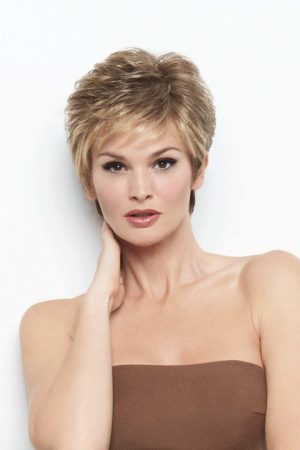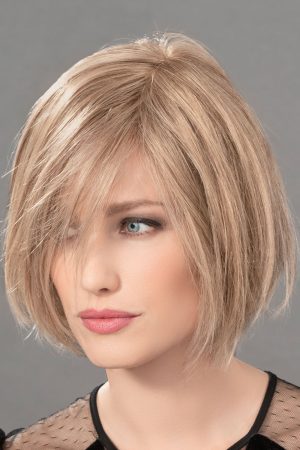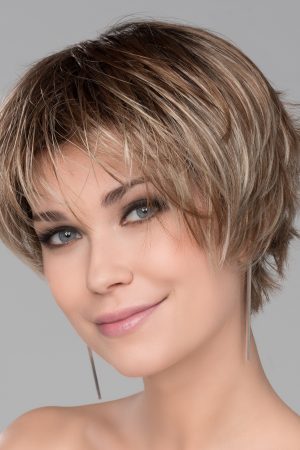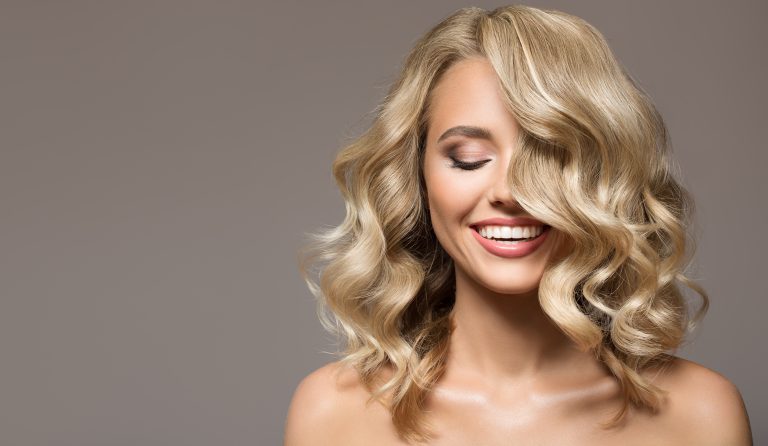When it comes to achieving the best result for a natural looking wig (regardless of the style being a human hair wig or synthetic wig) the density of the hair has a large impact on how realistic the wig looks. Low density wigs are simply less overwhelming and don’t come across as ‘wiggy’ when compared to their higher density counterparts. For wearers who are after the most natural looking result, it is very important that the wig is a low density. Not only will this look more realistic, the wig will be less overwhelming for the wearer. When going from little or no hair to having a wig on, more often than not, the result can feel very overwhelming, especially when the wig has a mid to high density. Low density is definitely the ideal for the majority of people, with the exception of wearers who like full hair styles or are performers.
What is a Low Density Wig?
A low density wig has less hair and little to no permatease (manufactured teasing to provide volume) that can be found in a lot of wigs. For those with thin or fine hair, a wig with permatease can feel like an overwhelming amount of hair. Lighter density wigs can provide a more realistic, natural look.
Wig density is expressed as a percentage that tells you how much hair is actually on your wig but does not refer to the texture. The higher the density percentage, the fuller it will look; the lower the density percentage, the thinner it will look.
Very Light Density: This density is 60% thickness of an average head of hair. It is recommended for people whose natural hair does not have much volume or thickness. Light density on a lace front or full lace wig shows a fair amount of scalp. This density is popular with elderly women.
Light Density: This density is 70 – 80% thickness which is an average head of hair. This density has less hair at the front/hair line with light/medium density everywhere else. This can offer a wig that mimics how a natural head of hair will look without any overwhelming experiences. Examples of this density can be found in our European Range, the Mia Euro & Bella Euro.
Light to Medium: This density is 130% thickness which is an average head of hair. This is the most popular density for full lace wigs. It means that full lace wig will have light density at the hairline and medium density every where else. This is a most natural looking and highly recommended as it is relatively easy to find this level of density wigs. This is the most popular density and suits most women.
Heavy: This density is 150% thickness of an average head of hair. We recommend this density if you would like a fuller look but would still like the unit to look natural.
Extra: This density is 180%-200% thickness of an average head of hair. This density in lace front wigs or full lace wigs is usually worn by performers who are after a big style. Wouldn’t recommend this density for someone after a natural look.
Types of Low Density Wigs
Density simply means how much hair is used to create your wig and therefore create fullness. The types of low density wigs have increased over the years with loads more styles being released offering low density wig options. Two wigs with the same hair density can be styled to look completely different and have a perception of different density. Rollers, heat styling can create more fullness. A full lace wig is a wig made with human hair hand tied to a lace base with the The hair being knotted into the lace. The result provides the illusion the hair is growing from the scalp.
Generally any wig style that has the words Lite in the name will have offer low density. You’ll find a vast array of styles of wigs available in low density; long, short, wavy, straight.
The Bella Euro and Mia Euro from Private Collection have both a low density and a lite version.
Choosing a Low Density Wig
The main things to look for when choosing your low density wig include a lace front and preferably a hand tied cap. The most realistic looking wig will have lower density at the hair line and front. Look for the wig that provides an end result you’ll be happy with… most human hair wigs will require some level of styling, just like your own biological hair. Whereas if you were to choose a synthetic the style will look how it arrives and go back to that style when washed.
Benefits of Wearing a Low Density Wig
For ladies who have experienced thinning, hair loss or are going through treatment resulting in losing their hair completely, a low density wig provides a beautiful way to bring your identity back and with that also your confidence can be restored too. For a large proportion of ladies, our hair is a big part of our identity, so it can be quite a confronting experience to lose hair. When we aren’t used to having a lot of hair, any wig may seem a little overwhelming. However with a low density wig, the result will be more realistic and natural looking. Most of the time, people won’t be able to tell if you’re wearing your low density wig or it’s your own hair!
Drawbacks of Wearing a Low Density Wig
Being low density means that there isn’t as much hair offered in the wig. So any loss of hair that can result from general day to day wear will be more noticeable. This is the reason we suggest a six month check up for our Bella Euro and Mia Euro wigs. Sometimes there may be a need to re knot in a few hairs from time to time.
Who Can Wear a Low Density Wig?
Anyone can wear a low density wig. Especially great for children too, a low density wig on a very small cap can be life changing for a child going through treatment or losing hair whilst still at school. Low density wigs are the ideal choice and recommended by most stylists as being the preferred density to create a more natural look for the wearer.
How to Care for a Low Density Wig
Being a little more delicate due to the lower density, it’s advisable to take extra care and be aware that certain things will affect your wig’s lifespan. Things to avoid include wearing glasses on the top of your head, wearing a hat on your wig, no swimming as salt water or chlorine will break down the hair fibres. When washing your low density wig, always have your thumb along the part line and hold firmly when you swish the wig through the shampoo water. When your wig is not being worn, keep her on a wig stand.








